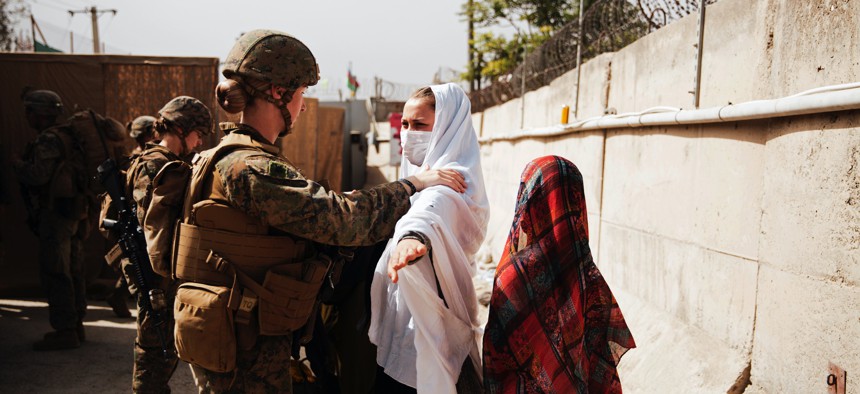CAITLIN M. KENNEY

More than 2,000 Marines are on the ground at Hamid Karzai International Airport as of Thursday, helping to process and evacuate Americans and Afghans while the Taliban’s grip on Kabul tightens around them.
“Their role now is a combination. They have elements that are part of the outer perimeter security, but also they have elements that are focused on the evacuation control centers, which requires not only the processing [of] individuals out of the country, but also the interior security for that,” Brig. Gen. Peter Huntley, the Marine Corps’ director of operations, told reporters at the Pentagon Thursday.
The Marine contingent brought the total U.S. force at the airport on Thursday to some 5,200 troops, mostly Army.
The Marines were ordered in last week to help secure the airport and get people out of the country as the Taliban were rapidly taking provincial capitals.
The first 50 arrived from Bahrain: an initial headquarters unit from Joint Task Force Crisis Response, which was “centered around” Task Force 51/5 Marine Expeditionary Brigade, Huntley said. This unit would provide command-and-control for the next Marines to arrive: members of the 24th MEU, including 1st Battalion, 8th Marines; and of Combat Logistics Battalion 24, both out of Camp Lejeune, North Carolina. Finally, members of the Special Purpose Marine Air-Ground Task Force Crisis Response Central Command arrived: Marines from 2nd Battalion, 1st Marines and Combat Logistics Regiment 1 out of Camp Pendleton, California.
By Thursday, the airport contingent included just over 1,200 Marines from the 24th MEU and about 800 Marines from the Special Purpose Marine Air-Ground Task Force, Huntley said. Both units were already in the region when they were tapped to respond to the crisis, which is what they are intended for.
Their first task was to secure the perimeter of the airport and clear the airfield, which had been overrun with civilians. Video and photos earlier this week showed people running after planes and climbing on a jet bridge. Huntley described it as “very challenging” for the small number of Marines who were first there.
One Marine suffered a graze wound to his leg from a bullet on Monday when there was an exchange of gunfire that Huntley described as pot shots. The Marine was “patched up” and returned to duty, he said.
“The assessment from the Marines on the ground—--that it wasn't Taliban- coordinated, there was no indication of that. And if you're familiar with Afghanistan, it could be a variety of individuals,” he said.
Once the field was cleared, U.S. military flights resumed, bringing more forces and gear.
Huntely said the perimeter is now mostly protected by soldiers from the Army’s 82nd Airborne Division, which has experience in doing just that.
The evacuation operation has since accelerated. Thursday saw double the amount of people processed as on Wednesday, Huntley said.
There are 6,000 people processed at the airport ready to board a plane, State Department spokesman Ned Price said Thursday.
The 24th MEU also has MV-22 Osprey aircraft in the region that could respond if needed, say to an airplane crash or if personnel need to be recovered, Huntley said. Marine KC-130 airlifters are moving people and equipment to Kabul. A detachment of Marine AV-8B Harrier jets from the 24th MEU are flying as part of the air tasking order over Afghanistan, he said.
In an interview with ABC News on Wednesday, Biden said troops may stay past the Aug. 31 withdrawal deadline to continue to evacuate Americans. However, Pentagon spokesman John Kirby said Thursday that an extension would have to be negotiated with the Taliban.
The Marines are “living expeditionary,” Huntley said, having brought enough food, water, and ammo in their bags to last them several days at the airport. “The Marines, they train to that, so it's to be expected in terms of either operations or exercises ashore during these type of deployments, that's basically the kind of the modus operandi for expeditionary living, if you will.”
No comments:
Post a Comment